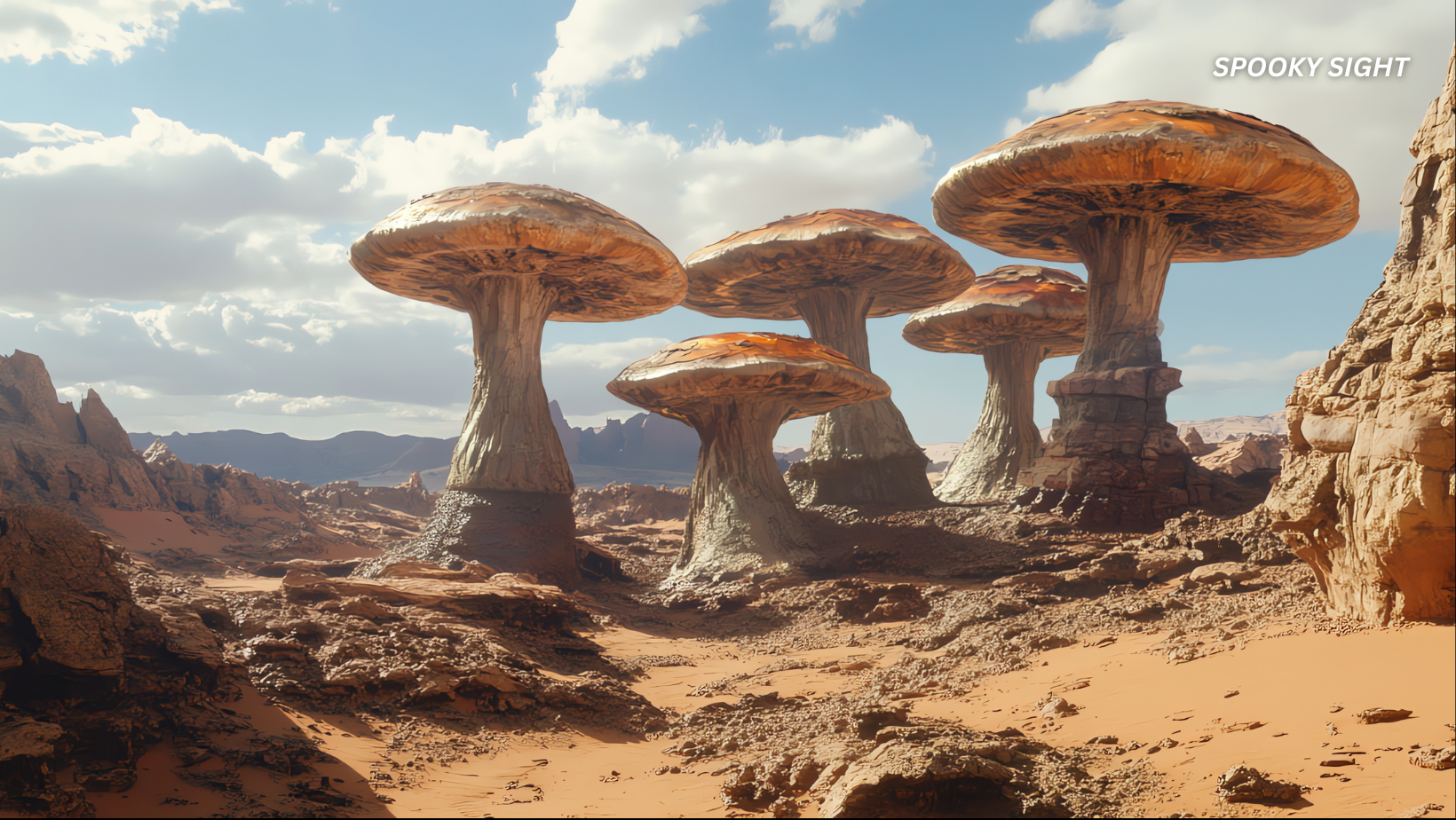If you could travel back in time about 420 million years, you might expect to see the beginnings of lush forests or early dinosaurs stomping around. But you’d be wrong. Instead, you’d find yourself in a world almost entirely empty — a place without trees, flowers, or grass. The tallest plants were only a few inches high, and most of the landscape was bare rock and soil.
Now imagine walking across this barren ground and suddenly looking up — way up — at a towering column that stretched nearly 24 feet (8 meters) into the sky. Its surface wasn’t covered in bark or leaves, but in the strange, fibrous texture of fungal tissue. This was Prototaxites, a giant fungus that, for millions of years, was the tallest living thing on Earth.
A World in Transition
The time between 420 and 370 million years ago — covering the late Silurian and early Devonian periods — was one of nature’s biggest transition phases. Life had begun to crawl out of the oceans, but the continents were still largely lifeless. Early plants, little more than green sticks, had only recently evolved the ability to stand upright. They had no leaves to capture sunlight efficiently and no roots to anchor them deeply or draw water from far underground.
This left the land wide open for something else to dominate. Enter Prototaxites — a fungal skyscraper in a world of ankle-high vegetation. It grew like a vertical log, as much as 3 feet (1 meter) thick, and stood out starkly against the low, scrubby growth of the time.
Read more: Woman Declared Dead for 8 Minutes Says She Discovered Death Is An Illusion
A Mystery That Stumped Scientists for Over a Century
The first fossils of Prototaxites were found in the mid-1800s. They looked like giant, petrified tree trunks — except they came from a time before trees existed. This baffled paleontologists. The possibilities ranged from seaweed that had adapted to land, to massive rolled-up mats of liverworts (small plants that still exist today), to lichens. Each theory sounded possible but had flaws.
For more than 130 years, the debate went on. Then in the early 2000s, a particularly well-preserved fossil was unearthed in Saudi Arabia, giving researchers the perfect specimen to test. In 2007, a team from the University of Chicago and the Smithsonian National Museum of Natural History decided to approach the puzzle from a new angle: chemistry.
Cracking the Code with Carbon Isotopes
Every living thing leaves behind chemical fingerprints in the form of isotopes — atoms of the same element that have slightly different weights. Plants get their carbon directly from the air, so plants of the same type have very similar isotope ratios. Animals and fungi, on the other hand, get their carbon from what they consume, which can create a much wider range of isotope patterns.
When scientists measured the carbon in Prototaxites fossils, they found that the ratios varied far more than any plant’s would. This was a clear sign that Prototaxites wasn’t photosynthesizing — it was eating. And that meant it had to be a fungus.
Why So Tall?
Modern mushrooms are usually small and short-lived, so the idea of a fungus reaching 24 feet sounds absurd. But paleobotanist Carol Hotton suggested a clever reason: reproduction. Fungi spread by releasing microscopic spores into the air. In a flat, treeless world, a tall fungus would have had a major advantage — it could scatter its spores over far greater distances, letting the wind carry them for miles.
Without forests to block airflow, the prehistoric wind was a perfect spore delivery system. The taller the fungus, the better the spread. In a way, Prototaxites was like a giant spore-launching tower.
The Prehistoric Dinner Menu
If Prototaxites was a fungus, what was it eating in a world with so little plant life? Scientists think it may have been a decomposer, feeding on dead plants, algae, and possibly even microbial mats that formed along shorelines. Some theories suggest it could have been a parasite, living off the limited vegetation of the time.
The variety in its carbon isotopes suggests it wasn’t picky — if it could break it down, it probably ate it. This flexibility might have helped it dominate for so long.
Read more: Meteorite Smashes Through Georgia Roof — And It May Be Older Than Earth Itself
Other Prehistoric Oddities
The Silurian and Devonian periods didn’t just have giant fungi — they were full of strange, transitional life forms. Around the same time, the first primitive insects and arthropods were appearing on land, likely crawling in the shadow of Prototaxites. In the oceans, armored fish called placoderms ruled the seas, some reaching lengths of over 20 feet themselves.
Meanwhile, the earliest forests were beginning to form in scattered patches. By about 385 million years ago, plants had developed true roots, leaves, and the ability to grow into actual trees. Once these leafy competitors took hold, Prototaxites began to disappear.
The End of a Fungal Empire
As trees rose up, they created dense canopies that blocked sunlight, altered the climate, and transformed the land into lush green ecosystems. Fungi like Prototaxites no longer had the open, sunny, and wind-swept environment that made their towering form so advantageous. Gradually, the mushroom monarchs vanished, leaving only fossilized stumps behind.
Today, the closest living relatives of Prototaxites are humble fungi no taller than your ankle — a far cry from their skyscraper-like ancestors. But those fossils are a reminder that Earth’s history has been full of surprising rulers, and that life’s dominant forms don’t always match what we see today.
Read more: What Is a Black Moon? The Rare Event Happening in August 2025 That Won’t Happen Again For Years
Fun Fact: The First Skyscrapers Weren’t Built by Humans
When we think of skyscrapers, we usually picture human-made marvels — sleek towers of glass and steel scraping the clouds. But the very first “skyscrapers” on Earth weren’t the work of architects or engineers. They were built by nature itself, hundreds of millions of years before the first human city existed.
The towering fungus Prototaxites may have been the earliest example of a vertical structure dominating a landscape. Rising as high as 24 feet, it was an imposing column in a world otherwise flat and empty. In the absence of trees or any kind of tall vegetation, Prototaxites would have stood out like a lighthouse on an open plain. Its height didn’t just make it remarkable — it made it influential.
These fungal towers may have acted as giant wind dispersal systems, releasing countless spores into the air, helping fungi and their microscopic allies spread far and wide. They may also have provided shade, shelter, or microhabitats for early insects, small arthropods, and primitive plants struggling to survive on land. In doing so, they played a quiet but critical role in shaping how life evolved.
Image: Freepik.









